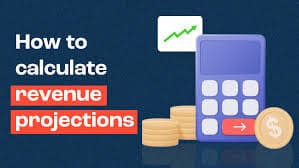Introduction
Accurate revenue projections are the bedrock of sound financial planning and strategic decision-making for businesses. The “Accurately Predict Future Revenue with Our Revenue Projection Calculator” guide explores the intricacies of revenue projection and introduces a powerful tool to assist in this process. Additionally, we delve into the advantages of incorporating tiered commission structures into the equation for a comprehensive approach to revenue forecasting.
Understanding the Importance of Revenue Projection
Revenue projection involves estimating future income based on historical data, growth factors, and market trends. This process is critical for businesses of all sizes, providing a roadmap for financial planning, resource allocation, and overall strategic decision-making. Accurate revenue projections are essential for instilling confidence in investors, guiding budgetary decisions, and ensuring long-term business sustainability.
Key Components of a Revenue Projection Calculator
- Historical Data Input: The calculator requires historical sales data, including revenue figures over a specified period.
- Growth Factor Integration: Incorporating growth factors helps account for anticipated changes in the market, industry trends, and the overall business environment.
- Tiered Commission Structure: The inclusion of a tiered commission structure allows businesses to tailor sales incentives based on performance levels, providing a dynamic element to the revenue projection process.
- Calculation Formula: Revenue projections are calculated using a formula that considers historical data, growth factors, and commission structures. The specific formula may vary based on the complexity of the calculator.
Navigating Our Revenue Projection Calculator Tool
4.1 Intuitive User Interface
Our Revenue Projection Calculator Tool boasts an intuitive user interface, ensuring accessibility for users with varying levels of expertise. The design prioritizes ease of navigation, making the tool user-friendly and efficient.
4.2 Inputting Historical Data
Users can easily input historical sales data into the calculator, providing the foundational information needed for accurate projections. This step is crucial for understanding past performance and trends.
4.3 Incorporating Growth Factors
The calculator allows users to incorporate growth factors, accounting for anticipated changes in the market and industry. This forward-looking approach ensures that revenue projections align with potential shifts in the business landscape.
4.4 Utilizing Tiered Commission Structures
A unique feature of our calculator is the incorporation of tiered commission structures. Users can define commission tiers based on performance thresholds, tailoring incentives to motivate sales teams and impact revenue projections positively.
4.5 Real-time Calculation and Visualization
Experience real-time calculation as the tool processes the provided data instantly. Visualizations, such as line graphs or bar charts, offer a clear representation of projected revenue trends, aiding users in interpreting results effectively.
The Significance of Tiered Commission Structures
5.1 Definition and Principles
Tiered commission structures involve setting different commission rates based on predefined performance thresholds. As sales representatives achieve higher sales volumes or meet specific targets, they progress through commission tiers, earning higher rates on their sales.
5.2 Advantages of Tiered Commission Structures
- Motivation and Performance: Tiered structures provide strong motivation for sales teams to exceed targets and progress through commission tiers, fostering healthy competition and improved performance.
- Flexibility and Adaptability: Businesses can adapt commission structures to align with changing business goals, ensuring that incentives remain relevant and impactful.
- Cost-Efficiency: By tying commissions to performance, businesses align compensation with revenue generation, ensuring a more cost-efficient approach to sales incentives.
5.3 Aligning Sales Incentives with Performance
Tiered commission structures effectively align sales incentives with performance levels, creating a win-win scenario for both sales representatives and the business. This alignment is particularly effective in driving revenue growth and achieving strategic objectives.
Integrating Tiered Commission Structures in Revenue Projections
6.1 Tailoring Commission Tiers to Business Goals
When integrating tiered commission structures into revenue projections, businesses must align commission tiers with broader organizational goals. This ensures that sales incentives drive behaviors that contribute directly to the desired outcomes.
6.2 Analyzing Historical Performance for Tier Optimization
Analyzing historical performance data provides insights into the effectiveness of existing commission structures. Businesses can optimize tier thresholds and commission rates based on past performance trends, ensuring that the structure remains motivating and achievable.
6.3 Motivating Sales Teams with Tiered Commissions
Communicating the benefits of tiered commissions to sales teams is crucial for motivation. Clearly outlining the structure, potential earnings, and the path to progression creates a transparent and motivational environment.
6.4 Real-world Examples of Successful Tiered Structures
Exploring real-world examples of successful tiered commission structures in similar industries can provide valuable insights. Case studies and examples showcase how businesses have effectively implemented tiered commissions to drive sales and achieve revenue goals.
Benefits of Accurate Revenue Projections
7.1 Informed Financial Planning
Accurate revenue projections serve as the foundation for informed financial planning. Businesses can allocate resources effectively, set realistic budgets, and make strategic investment decisions based on reliable revenue forecasts.
7.2 Resource Allocation and Budgeting
Understanding future revenue trends allows businesses to allocate resources efficiently. Whether it’s budgeting for marketing initiatives, expanding teams, or investing in technology, accurate projections provide a roadmap for optimal resource allocation.
7.3 Strategic Decision-making
Accurate revenue projections contribute to strategic decision-making by providing a clear understanding of potential income streams. This foresight allows businesses to make informed decisions about product development, market expansion, and overall business strategy.
7.4 Investor and Stakeholder Confidence
Investors and stakeholders place significant value on businesses that demonstrate a clear understanding of their future revenue potential. Accurate projections instill confidence, fostering positive relationships with those who have a vested interest in the success of the business.
Conclusion
In conclusion, “Accurately Predict Future Revenue with Our Revenue Projection Calculator” emphasizes the critical role of accurate revenue projections in strategic business planning. The Revenue Projection Calculator Tool introduced in this guide provides a comprehensive and dynamic approach to forecasting future income. Additionally, the integration of tiered commission structures enhances the depth and effectiveness of revenue projections, aligning sales incentives with organizational goals.
By adopting these tools and strategies, businesses can navigate the complexities of revenue forecasting with confidence, maximize sales team performance, and position themselves for sustained success in a competitive business landscape.











